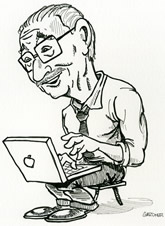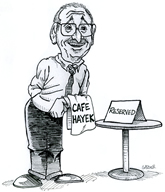The Economist offers an explanation of “why Donald Trump’s protectionist zeal has only grown.” Two slices:
Donald trump’s supporters celebrate him as a man who says what he means and means what he says. The trade crisis he ignited over the past week has provided more proof, if any was needed, that this reputation is undeserved. Yes, Mr Trump has been clear that he loves tariffs, but he is vague and even misleading about what this ardour means in practice. That has made for a remarkably chaotic start to his new administration, with businesses, investors and other governments all trying to figure out exactly what he wants—and most now bracing for more turbulence.
Not once in the lead-up to the election did he mention the possibility of tariffs aimed at both Canada and Mexico, America’s biggest trading partners. Yet his first move on trade after taking office was to announce hefty levies on the pair, threatening to blow up a North American pact renegotiated in his first term. As justification, he invoked an emergency on America’s borders from an influx of drugs and illegal migrants, only to then say that what really bothered him was America’s trade deficit. Meanwhile, his most radical campaign proposal—a universal tariff on imports—has, for now, been supplanted by talk of more targeted levies.
…..
Mr Trump’s new tariffs also arrived suddenly. In his first term he provided months-long notice to affected firms. This time, he announced the tariffs on February 1st, and importers were due to start paying the levies three days later. Mr Trump has also let it be known that he is far from done. He has said that he will “absolutely” implement tariffs on the European Union and has pledged to slap levies of as much as 100% on Taiwanese semiconductors. “He has come right out of the starting gate, going after our close friends and allies,” says Douglas Irwin of Dartmouth College. “He is so much more brazen.”
A second lesson is that Mr Trump is a true believer in tariffs, seeing them as a singularly effective tool for achieving multiple objectives. This is why there are so many different interpretations of his philosophy: they can all apply at different times. Mr Trump unquestionably views tariffs as leverage, and is not wrong that America, the world’s largest importer, has an advantage in any trade war. Consider the country’s relationship with its neighbours. Exports to America are worth roughly 20% of Canadian GDP and 30% of Mexican GDP. By contrast, American exports to Canada and Mexico combined are worth just 3% or so of American GDP.
Mr Trump believes that tariffs can be a large revenue source, too, helping wean America off income tax. Never mind that any reasonable estimate shows they would pay for only a fraction of federal spending. Mr Trump also thinks tariffs will prompt a manufacturing renaissance—another idea scoffed at by economists since tariffs raise input costs and shield inefficient producers. Mr Trump’s belief in tariffs can thus be said to be overdetermined.
Omar Barbiero and Hillary Stein examine the likely unhappy effects of Trump’s tariffs on prices.
The empirical evidence, of course, shows that a tariff is nothing like a tax on a foreign country. It is a tax on domestic consumers, because it does get passed on to them. But does it at least stimulate domestic industry?
Well, some industries, sure. But, as mentioned, it can only have that effect if it hits consumers where it hurts, thus making them poorer. These poorer consumers will now have to cut back on something else, so inevitably, some other industries will suffer. You cannot tariff yourself rich.
There are no good arguments for tariffs, just as there are no good arguments for price controls.
They cause clear economic harm, they don’t achieve any of the things their supporters claim, and they are especially susceptible to special interest capture. There is no upside.
The Editorial Board of the Wall Street Journal looks at the latest U.S. jobs report. A slice:
The job losses in autos and chip-making are notable given the Biden Administration’s enormous subsidies. Mr. Biden claimed his force-fed electric-vehicle transition and industrial policy would create hundreds of thousands of auto jobs, but the job report dispels that fantasy.
The robust job growth in November and December may reflect the revival in animal spirits after Mr. Trump’s election as the threat of higher taxes and more regulation receded. But the slower growth in January is a warning to Mr. Trump to tread carefully on his tariff agenda.
Consumer confidence has recently slid amid worries about the tariff impact. The University of Michigan’s consumer survey for February showed inflation expectations for the next year increased to 4.3% from 3.3% in January. One risk is that businesses, especially manufacturers, will hold off investing and hiring amid continued uncertainty over tariffs.
Wall Street Journal columnist Mary Anastasia O’Grady separates fact from Trumpian fiction about the Panama Canal. Two slices:
Secretary of State Marco Rubio went on Fox last week to cite a “Hong Kong shipping vessel” in the Panama Canal as evidence that China is exercising “effective control” of the waterway. He was wrong on two fronts. First, the Panamanian-flagged ship belonged to a South Korean company. Second, the 47-year-old U.S.-Panama treaty governing “the permanent neutrality and operation” of the canal means ships from any country are allowed to use it.
Mr. Rubio knows this. He loudly denounced Cuba’s effort to sneak arms through the canal to North Korea in 2013. But ever since President Trump announced on Dec. 21 that he wants to tear up the treaty and reclaim the canal for Americans, fiction has ruled the U.S. narrative.
…..
China does present cyber threats to the canal, the ambassadors said. But such attacks “can be launched from anywhere in the world.” That’s why, “in the spirit of upholding the Neutrality Treaty,” the canal authority recently signed a cybersecurity agreement with U.S. Southern Command.
The antidote to China’s “creeping commercial expansion” in Panama, the ambassadors wrote, is greater “U.S. commercial interest and activity.” Instead, the Trump administration is making stuff up, swinging a big stick, and humiliating a friend. This is strengthening the anti-American left in the country. That’s not diplomacy. It’s insanity.
Andy Kessler is understandably bullish about the long-run economic consequences of AI. Here’s his conclusion:
As happened with operators, tellers, travel agents and so on, jobs lost are replaced by new and better-paying jobs in emerging industries. Every time. Yes, AI is now going after white-collar jobs with a vengeance, but that means freeing up capital to fund new technologies that don’t yet exist (laundry folding robots, please). McKinsey projects that “8 to 9 percent of 2030 labor demand will be in new types of occupations that have not existed before.” Eventually, AI will enable 25% and then 50% of productive but never-existed-before new jobs.
Arnold Kling continues to write importantly and wisely.
David Osborne reminds us that Trump’s pick for Labor secretary is a friend of Labor, not of workers.
Reason‘s Robert Poole offers sound advice on how to improve U.S. air-traffic control. A slice:
America’s air-traffic control system is decades behind those of Australia, Canada, Germany, Italy and the U.K. While these nations build safer, cheaper and more effective digital control towers that can be stationed off-site, the FAA continues to build the traditional towers of years past. While American control-tower staff share flight information with each other via paper flight strips, other countries use electronic flight strips with interactive displays and real-time data. Other providers subscribe to a global space-based surveillance system to track aircraft where there is no radar, such as over the oceans. The FAA doesn’t.



